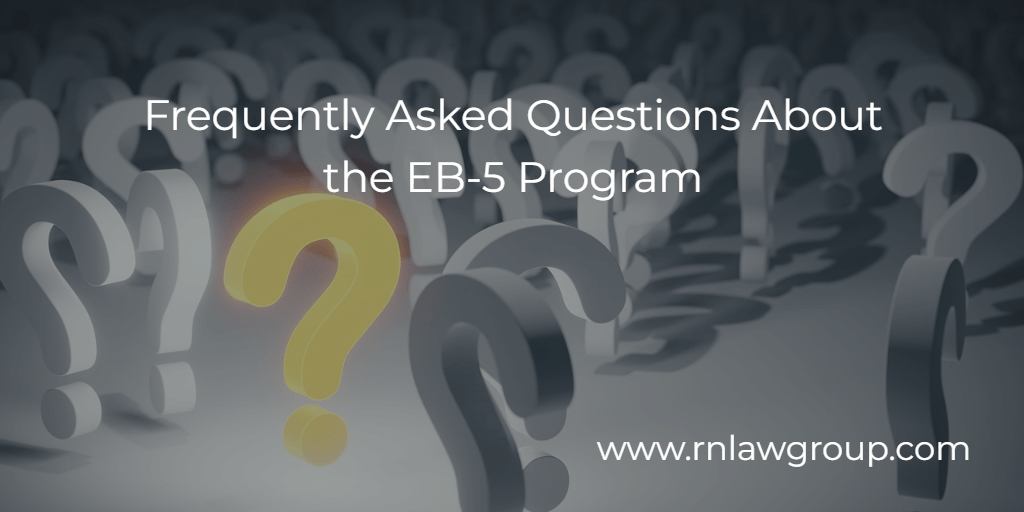
Frequently Asked Questions About the EB-5 Program
Given the state of the visa bulletin in recent years, more and more individuals are looking for options outside of EB-2 and EB-3 in order to get their green cards. In recent years, EB-1A and EB-1C have become more popular, especially with the current administrations focus on STEM (EB-1A) and companies allowing remote work (EB-1C). However, not everyone will meet the stringent criteria for an EB-1 and are still looking for options. Enter the possibility of an EB-5 green card. The EB-5 program was revamped in 2022 and provides for new investment amounts, new reservations of green cards through targeted areas, and more changes. As this program is increasingly appealing to many, our team has seen a number of questions regarding the EB-5 program, and we have put together an article on EB-5 frequently asked questions.
- What are the general EB-5 requirements?
- There are three main elements to an EB-5, the investment of the minimally required capital that is “at risk”, in a new commercial enterprise, that creates 10 US jobs per investor.
- Does an EB-5 get me the same green card as an EB-2 or EB-3?
- Not necessarily. While the green card will come with the same rights, you will only receive a two year conditional green card. Prior to that expiration, you will have to apply for a removal of conditions to get the permanent green card. This application requires you to show that you still meet the EB-5 criteria and conditions.
- What are the investment amounts for EB-5?
- Pursuant to the new EB-5 law, the EB-5 Reform and Integrity Act of 2022, the investment amounts are $800,000 for “targeted employment areas” and $1,050,000 for non-target employment areas. These will increase starting January 1 2027 and every 5 years thereafter.
- What is a targeted employment area?
- A targeted employment area (“TEA”) is a rural or high unemployment area at the time of investment.
- A rural area is defined as any area other than a metropolitan statistical area or one having a population of 20,000 or more within the outer part of any city or town.
- A high unemployment area is defined as one that experiences unemployment of at least 150% of the national average.
- How are TEAs defined?
- DHS makes the sole designation of TEAs based on census data. The Bureau of Labor Statistics and Census Data will be key resources for an individual to review.
- Can I concurrently file for an EB-5 and an I-485?
- Yes, in the past this was not allowed, but with the passing of the 2022 EB-5 law, Congress authorized, and USCIS accepts, concurrent filing of the EB-5 and the I-485 as long as the priority date is current and being accepted. By filing concurrently an individual can file for work and travel authorization associated with the I-485.
- The visa bulletin lists four different EB-5 categories, how do I read this to determine if I am current?
- With the 2022 EB-5 law, there are now the three EB-5 set asides for TEAs and infrastructure investments. 20% of the available EB-5s are set aside for rural investments, 10% are set aside for high-unemployment area investments, and 2% are set aside for infrastructure investments. The remainder is unreserved and would fall in that category. So when putting together your petition, you would need to look at which category you are seeking to determine if you are current.
- In the past, the visa bulletin used to differentiate between regional center and non-regional center and the current visa bulletin does not, is the regional center program dead?
- No it is not. However, with the 2022 EB-5 law, the investments are either classified as reserved or unreserved. You can still invest in a regional center, but will want to do your research into whether it is reserved or unreserved for purposes of the visa bulletin.
- What is a “new commercial enterprise?”
- Congress has defined it as a for profit organization conducting lawful business. In order for the enterprise to be “new” the investment must generally be in an entity formed after November 29, 1990.
- The business can be a sole proprietorship, partnership, holding company and its subsidiaries, joint venture, corporation, business trust, or other publically and privately owned entities as long as they are for profit.
- How does the EB-5 program define “capital” or money?
- Capital is defined by Congress has “cash and all real, personal, or mixed tangible assets owned and controlled by the alien investor, or held in trust for the benefit of the alien and to which the alien has unrestricted access.”
- Is there any limitation on capital?
- Yes, the capital must be “at risk” and cannot include assets acquired through unlawful means, capital invested in exchange for a note, bond, obligation, or other debt arrangement, capital invested with a guaranteed rate of return, and capital that is subject to any agreement that gives the investor the right to repayment.
- Can the capital be from a gift of money?
- Yes, as long as the gift was in good faith and the money used for the gift was secured through lawful means. Gifts must be given without expectation of repayment.
- Can the capital be from a loan?
- Yes, it can but the loan cannot come from the new commercial enterprise. The investor should be personally and primarily liable for debt.
- Do I just get to say where the money is from for an EB-5 investment?
- No, Congress has mandated that there must be a review of documentation to show “source of funds.” This must include tax records, monetary judgments against the investor or any pending civil or criminal actions, the identity of all persons who transfer money to the investor.
- One must show that they are the legal owner of the capital
- Can I just hold the funds in reserves?
- No, funds that are set aside as reserved and not available to the job-creating enterprise cannot be considered part of the calculation for capital.
- What is the requirement for creation of 10 jobs for an EB-5?
- The enterprise must create full-time employment for 10 positions for US Workers. This includes US citizens, green card holders (conditional and permanent), asylees, refugees, or grantees of suspension of deportation. While the entity can hire H-1B workers, nonimmigrant visa holders (H, TN, L, F, O, etc.) do not count towards the 10 employee count.
- The need for these employees must be shown on the business plan as being needed within 2 years commencing six months of the adjudication of the I-526.
- If you invest in a regional center, petitioners are able to count indirect jobs that are created.
- Do I as the investor or my derivatives count as part of the 10 employees?
- No, the 10 employees cannot include the investor or their spouse or children.
- What does the business need to show in order to prove to US that it will be operational and create the 10 jobs?
- USCIS requires a comprehensive business plan. Regulations define this requirement as a requirement to submit “a comprehensive business plan showing that, due to the nature and projected size of the new commercial enterprise, the need for not fewer than ten (10) qualifying employees will result, including approximate dates, within the next two years, and when each employee will be hired.”
- Multiple cases with USCIS has provided details on the business plan requirements, and more details on the business plan and the key elements required in an EB-5 business plan can be found here.
- If I only get a 2 year conditional green card, what is required to get the permanent green card?
- Within 90 days of expiration of the conditional green card, one must file an I-829 to “remove the conditions” of the conditional green card.
- The I-829 petition must show that the required capital was invested and sustained throughout the conditional residence status and that the conditional permanent resident created or is actively in the process of creating 10 full-time jobs.
The EB-5 visa provides an excellent opportunity for individuals and families to obtain permanent U.S. residency through investment. However, the program has complex requirements and applicants face the risk of denial if documents are not prepared and filed correctly. Given the large investment required, it is highly advisable to have an experienced immigration attorney guide you through the immigration portion of the process. A qualified attorney will ensure your business plan and supporting documents meet EB-5 standards, properly review the source of and document your invested capital, and correctly file your I-526 and eventually I-829 petitions. With so much on the line, our attorneys have the expertise to give your EB-5 application the greatest chance of success. We look forward to discussing your case and helping make the American dream of permanent residency a reality for you and your family. Contact us to discuss the EB-5 program.
Reddy Neumann Brown PC, located in Houston, Texas, has been serving the business community for over 25 years and is Houston’s largest immigration law firm focused solely on U.S. Employment-based immigration. We work with both employers and their employees, helping them navigate the immigration process quickly and cost-effectively.
By: Steven Brown
Steven Brown is a Partner at Reddy Neumann Brown PC where he works in the Non-immigrant visa department and leads the Litigation Team. His practice covers all phases of the non-immigration visa process including filing H-1B, L-1, E-3, H-4, and H-4 EAD petitions. In the last two years, Steven has successfully handled over 1,000 non-immigrant visa petitions including filing petitions, responding to any necessary Requests for Evidence, and drafting motions and appeals. He has also become a key resource for F-1 students that seek guidance on properly complying with the F-1 visa regulations and any OPT or CPT issues they may have. Additionally, Steven holds a weekly conference call for companies that are part of one of the largest organizations for IT Services companies in America.

